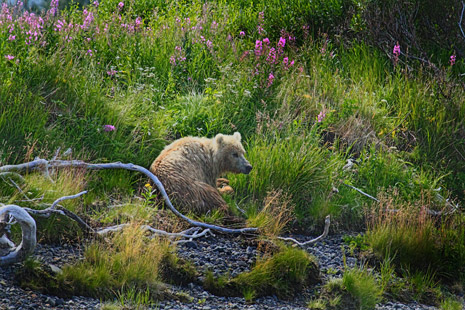Technique: Bears at the end of the stream
Get your mind right for takeoff
 It was in the 1967 movie Cool Hand Luke that a prison captain in charge of a work detail warned his prisoners that if they run twice, they will wear two sets of chains. “You ain’t gonna need no third set, ’cause you gonna get your mind right.”
It was in the 1967 movie Cool Hand Luke that a prison captain in charge of a work detail warned his prisoners that if they run twice, they will wear two sets of chains. “You ain’t gonna need no third set, ’cause you gonna get your mind right.”
Sometimes an accident will do that to pilots. One pilot who shared his experience so others could learn is a good example. He landed in Florida’s Tampa Bay after an engine failure, and now won’t fly across any large body of water without a life vest and an inflatable raft. Without those on board, he goes around. He never again needs to feel the sandy bottom of Tampa Bay between his toes as he pushes toward the surface.
Sometimes it doesn’t take an accident to get your mind right before takeoff. It just takes awareness of what can go wrong, and a mental checklist of what you’ll do if something happens. Examples are the single-engine pilots using urban-surrounded airports who have scouted the surrounding neighborhood for a suitable landing site in case of engine failure on takeoff.
K-Bay Air guided wilderness tours had a recent incident that offers another example of a mental checklist prepared well in advance. A Cessna 206 caught a wheel in the surf along a beach at Alaska’s Katmai National Park, best known as the place where brown bears fish for salmon.
The airplane was destroyed, although there were no injuries. The media had a feeding frenzy to rival that of the bears, calling the passengers “survivors,” although their only discomfort came from returning to their homes and hotels three hours later than expected.
K-Bay Air official Michael Hughes of Homer, Alaska, said his pilot was mentally prepared for a failed takeoff. Hughes was along on the trip in a second aircraft, which also was carrying tourists.
“Shock is one of the first reactions [to any incident]. You don’t believe it happened,” Hughes said. “During that phase, you’ll do nothing, wasting precious time. The more you plan in advance for such an occurrence, the faster you’ll get through that phase,” he added. The K-Bay pilot quickly shut off fuel and electrical power, determined that his door was blocked by damage to the left side of the airplane, and directed passengers out the rear doors—because that was the plan he had worked out ahead of time.
The company has an excellent safety record and had followed procedures that day. Since the tide can change the contour of the beach in a matter of hours, the pilots of the two tour aircraft had walked the takeoff path in both directions. The beach had more bumps than usual that day. Three-quarters of the way through the takeoff run, a bump launched the aircraft into the air before it was ready to fly. Drifting sideways and downward, its left wheel caught in the surf and tipped into the water, where it stopped.
The brown bears, the subjects of the excursion, were a quarter-mile away hunting salmon and paid absolutely no attention.
Hughes suggests that when you power up for launch, you pause to consider your procedures in case you abort the takeoff. Do you have a decision point in mind? When and where on the runway will you do it?
The worst outcome for Hughes came from reporters who somehow inflated the nonevent into a catastrophe. He continues to operate safely in Katmai and Lake Clark National Park, located across the Cook Inlet from the Kenai Peninsula, 100 miles southwest of Anchorage. K-Bay Air is one of a dozen air taxi and tour operators in those areas serving the tourist industry.
His passengers were on a seven-hour, $650 tour that always finds bears for its customers to photograph. Nearly three hours of the total time are spent flying to and from the park, a route that—on a clear day—provides spectacular scenery. Three hours are spent on the scene, observing some of the 2,000 bears found in the Katmai area.
The lesson already learned by K-Bay Air pilots—and put into practice—was to prepare for what could go wrong prior to takeoff. Experienced pilots, Hughes said, generally have the greatest awareness of what can go wrong, and prepare a mental checklist for what-if situations. For the K-Bay Air pilot, that checklist served him well, saving precious seconds that fortunately weren’t needed.
Air safety institute Videos on Takeoffs and Landings
The Air Safety Institute has produced a number of online videos in its education series to help pilots make safe takeoffs and landings.
• Takeoffs and Landings: Normal Takeoffs
A “normal” takeoff is what pilots use for the majority of their departures, but it often doesn’t get the attention it deserves.
• Takeoffs and Landings: Short Field Landings
While the checklist is important for determining how to perform a short field landing, sometimes it helps to think about why we do what we do.
• Takeoffs and Landings: Determining an Abort Point
When it comes to making a safe takeoff, there are simple rules of thumb we can all live by. Knowing when to abort a takeoff is one of them. Learn how to choose an abort point if your takeoff roll isn’t going as planned.
These and other educational videos can be viewed online.
On the web:
Bearcams: Want to see the bears catch salmon at the Katmai National Park? Here’s a Web page with four cameras.
Learn more about tours by K-Bay Air.
Email [email protected]



